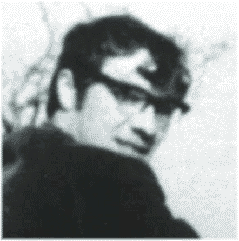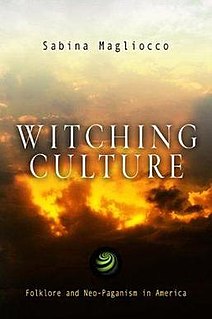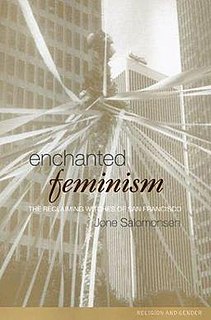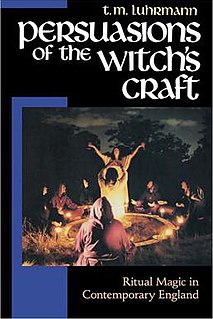Related Research Articles

Gardnerian Wicca, or Gardnerian witchcraft, is a tradition in the neopagan religion of Wicca, whose members can trace initiatory descent from Gerald Gardner. The tradition is itself named after Gardner (1884–1964), a British civil servant and amateur scholar of magic. The term "Gardnerian" was probably coined by the founder of Cochranian Witchcraft, Robert Cochrane in the 1950s or 60s, who himself left that tradition to found his own.

Wicca is a modern pagan religion. Scholars of religion categorise it as both a new religious movement and as part of the occultist stream of Western esotericism. It was developed in England during the first half of the 20th century and was introduced to the public in 1954 by Gerald Gardner, a retired British civil servant. Wicca draws upon a diverse set of ancient pagan and 20th-century hermetic motifs for its theological structure and ritual practices.

The New Forest coven were an alleged group of witches who met around the area of the New Forest in southern England during the early 20th century. According to his own claims, in September 1939, a British occultist named Gerald Gardner was initiated into the coven and subsequently used its beliefs and practices as a basis from which he formed the tradition of Gardnerian Wicca. Gardner described some of his experiences with the coven in his published books Witchcraft Today (1954) and The Meaning of Witchcraft (1959) although on the whole revealed little about it, saying he was respecting the privacy of its members. Meanwhile, another occultist, Louis Wilkinson, corroborated Gardner's claims by revealing in an interview with the writer Francis X. King that he too had encountered the coven and expanded on some of the information that Gardner had provided about them. According to Gardner, the faith which they followed was the continuation of the Witch-Cult, a pre-Christian religion that originated in the paganism of ancient Western Europe. This was in keeping with the widely held theories then propagated by the anthropologist Margaret Murray and her supporters.

Janet Farrar is a British teacher and author of books on Wicca and Neopaganism. Along with her two husbands, Stewart Farrar and Gavin Bone, she has published "some of the most influential books on modern Witchcraft to date". According to George Knowles, "some seventy five percent of Wiccans both in the Republic and Northern Ireland can trace their roots back to the Farrars."
As of 2022 held every year since 1968, the Quest Conference is an annual gathering of pagan practitioners, authors and interested newcomers in the Bristol area of the UK. It is organised by Marian Green, editor of Quest and the author of over twenty books on witchcraft, magic and the Western Mysteries.
A solitary witch is one who chooses to practice their spiritual faith in the privacy of their home or other designated space, without the need to participate in a group such as that of a Wiccan coven; although it’s not uncommon for solitaries to participate in some communal activities. Many solitary practitioners are Neo-pagans, who adhere to a diverse group of pagan religions that include various forms of Wicca, Traditional Reconstructionism and Traditional British Witchcraft, among others. About half of all pagans are self-ascribed solitary practitioners.

Philip Heselton is a retired British conservation officer, a Wiccan initiate, and a writer on the subjects of Wicca, Paganism, and Earth mysteries. He is best known for two books, Wiccan Roots: Gerald Gardner and the Modern Witchcraft Revival and Gerald Gardner and the Cauldron of Inspiration, which gather historical evidence surrounding the New Forest coven and the origins of Gardnerian Wicca.

Robert Cochrane, who was born as Roy Bowers, was an English occultist who founded the tradition of Witchcraft known as The Clan of Tubal Cain.
The history of Wicca documents the rise of the Neopagan religion of Wicca and related witchcraft-based Neopagan religions. Wicca originated in the early twentieth century, when it developed amongst secretive covens in England who were basing their religious beliefs and practices upon what they read of the historical Witch-Cult in the works of such writers as Margaret Murray. It also base the beliefs from the magic that Gerald Gardner saw when he was in Africa.It was subsequently Founded in the 1950's by a man called Gerald Gardner, who claimed to have been initiated into the Craft – as Wicca is often known – by the New Forest coven in 1939. Gardner's form of Wicca, the Gardnerian tradition, was spread by both him and his followers like the High Priestesses Doreen Valiente, Patricia Crowther and Eleanor Bone into other parts of the British Isles, and also into other, predominantly English-speaking, countries across the world. In the 1960s, new figures arose in Britain who popularized their own forms of the religion, including Robert Cochrane, Sybil Leek and Alex Sanders, and organizations began to be formed to propagate it, such as the Witchcraft Research Association. It was during this decade that the faith was transported to the United States, where it was further adapted into new traditions such as Feri, 1734 and Dianic Wicca in the ensuing decades, and where organizations such as the Covenant of the Goddess were formed.

Wiccan morality is largely expressed in the Wiccan Rede: 'An' ye harm none, do what ye will' - old-fashioned language for 'as long as you aren't harming anyone, do as you wish'. While this could be interpreted to mean "do no harm at all," it is usually interpreted as a declaration of the freedom to act, along with the necessity of thinking through and taking responsibility for the consequences of one's actions.

The Museum of Witchcraft and Magic, formerly known as the Museum of Witchcraft, is a museum dedicated to European witchcraft and magic located in the village of Boscastle in Cornwall, south-west England. It houses exhibits devoted to folk magic, ceremonial magic, Freemasonry, and Wicca, with its collection of such objects having been described as the largest in the world.
In Modern English, the term Wicca refers to Wicca, the religion of contemporary Pagan Witchcraft. It is used within the Pagan community under competing definitions. One refers to the entirety of the Pagan Witchcraft movement, while the other refers explicitly to traditions included in what is now called British Traditional Wicca.

A Community of Witches: Contemporary Neo-Paganism and Witchcraft in the United States is a sociological study of the Wiccan and wider Pagan community in the Northeastern United States. It was written by American sociologist Helen A. Berger of the West Chester University of Pennsylvania and first published in 1999 by the University of South Carolina Press. It was released as a part of a series of academic books entitled Studies in Comparative Religion, edited by Frederick M. Denny, a religious studies scholar at the University of Chicago.

Witching Culture: Folklore and Neo-Paganism in America is a folkloric and anthropological study of the Wiccan and wider Pagan community in the United States. It was written by the American anthropologist and folklorist Sabina Magliocco of California State University, Northridge and first published in 2004 by the University of Pennsylvania Press. It was released as a part of a series of academic books titled 'Contemporary Ethnography', edited by the anthropologists Kirin Narayan of the University of Wisconsin and Paul Stoller of West Chester University.

Enchanted Feminism: The Reclaiming Witches of San Francisco is an anthropological study of the Reclaiming Wiccan community of San Francisco. It was written by the Scandinavian theologian Jone Salomonsen of the California State University, Northridge and first published in 2002 by the Routledge.

Never Again the Burning Times: Paganism Revisited is an anthropological study of the Wiccan and wider Pagan community in the United States. It was written by the American anthropologist Loretta Orion and published by Waveland Press in 1995.

Living Witchcraft: A Contemporary American Coven is a sociological study of an American coven of Wiccans who operated in Atlanta, Georgia during the early 1990s. It was co-written by the sociologist Allen Scarboro, psychologist Nancy Campbell and literary critic Shirley Stave and first published by Praeger in 1994. Although largely sociological, the study was interdisciplinary, and included both insider and outsider perspectives into the coven; Stave was an initiate and a practicing Wiccan while Scarboro and Campbell remained non-initiates throughout the course of their research.

Persuasions of the Witches' Craft: Ritual Magic in Contemporary England is a study of several Wiccan and ceremonial magic groups that assembled in southern England during the 1980s. It was written by the American anthropologist Tanya M. Luhrmann (1959–) of the University of California, San Diego, and first published in 1989.

Witchcraft and Paganism in Australia is an anthropological study of the Wiccan and wider Pagan community in Australia. It was written by the Australian anthropologist Lynne Hume and first published in 1997 by Melbourne University Press.

Magic, Witchcraft and the Otherworld: An Anthropology is an anthropological study of contemporary Pagan and ceremonial magic groups that practiced magic in London, England, during the 1990s. It was written by English anthropologist Susan Greenwood based upon her doctoral research undertaken at Goldsmiths' College, a part of the University of London, and first published in 2000 by Berg Publishers.
References
- 1 2 3 4 5 STR (2002). "Green, Marian (1949– )". In Rabinovitch, Shelley; Lewis, James R. (eds.). The Encyclopedia of Modern Witchcraft and Neo-Paganism. New York: Citadel. p. 120. ISBN 9780806524061.
- 1 2 Luhrmann, T. M. (1989). Persuasions of the Witch's Craft: Ritual Magic in Contemporary England . Cambridge, Massachusetts: Harvard. p. 77. ISBN 9780674663237.; repr. London: Picador, 1994, ISBN 9780330329460.
- ↑ The Cauldron 143, Feb. 2012, p. 56.
- ↑ Sutcliffe, Steven (2002). Children of the New Age: A History of Spiritual Practices. Routledge. p. 28.[ dead link ][ ISBN missing ]
- ↑ Hutton, Ronald (1999). The Triumph of the Moon: A History of Modern Pagan Witchcraft . Oxford. p. 337. ISBN 9780198207443.
- ↑ Harvey, Graham (1997). Listening People, Speaking Earth: Contemporary Paganism. London: Hurst. pp. 50, 233. ISBN 9781850652717.
- ↑ Hutton, pp. 337, 384.
- ↑ Murphy-Hiscock, Arin (2006). The Way Of The Green Witch: Rituals, Spells, And Practices to Bring You Back to Nature. Avon, Massachusetts: Provenance. pp. 14–15. ISBN 9781593375003.
- ↑ Pike, Sarah M. (2004). New Age and Neopagan Religions in America . Columbia contemporary American religion series. New York: Columbia. p. 37. ISBN 9780231124027.
By changing our point of view, by developing our own inner skills.
- ↑ Luhrmann, p. 169.
- ↑ Green, Marian, Magic in Principle and Practice, Quest, 2010 (3rd edition), pp. 49-50.
- ↑ Quest 169, March 2012, p. 22
- ↑ "Books by Marian Green". Quest. Retrieved 16 July 2013.
- ↑ Reid, Síân (1996). "As I Do Will, So Mote It Be: Magic as Metaphor in Neo-Pagan Witchcraft". In Lewis, James R. (ed.). Magical Religion and Modern Witchcraft. Albany, New York: State University of New York Press. p. 151. ISBN 9780585036502.
- ↑ Hutton, p. 384.
- ↑ Luhrmann, pp. 35, 36, 77.